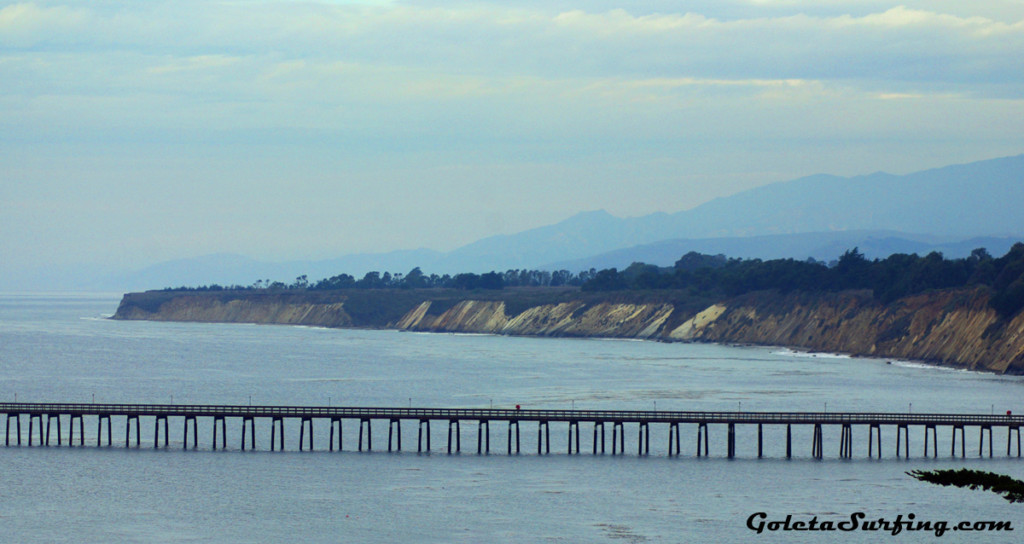
Haskells pier. A definitive marker for the end of the developed coastline and the beginning of the Gaviota Coast. 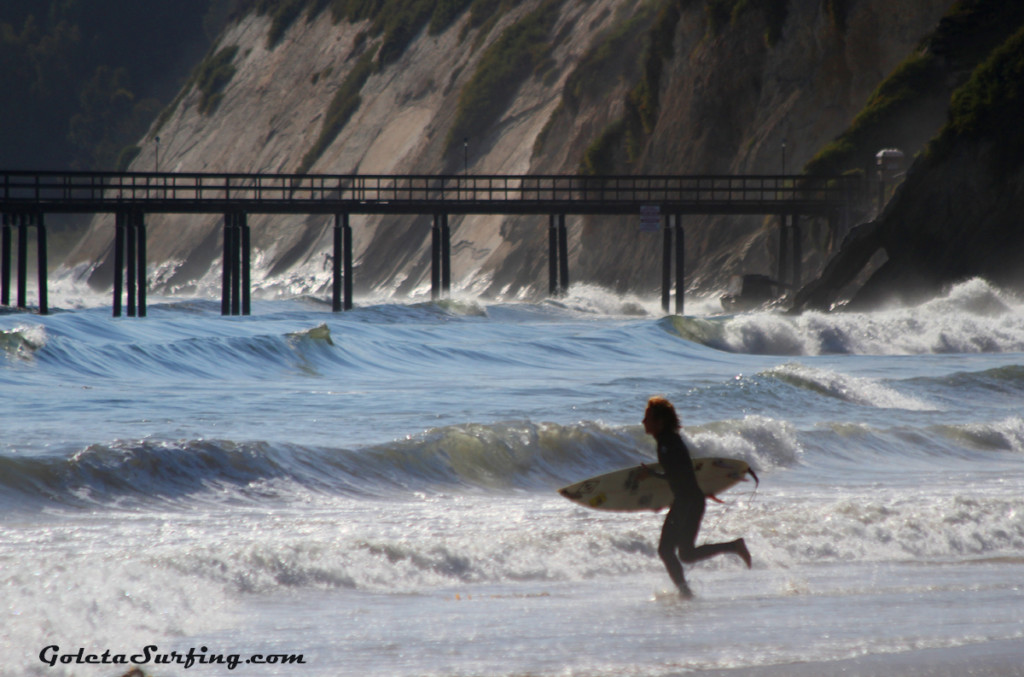 If you grew up in Goleta, this pier has been in the background of lots of beach day photos…
If you grew up in Goleta, this pier has been in the background of lots of beach day photos…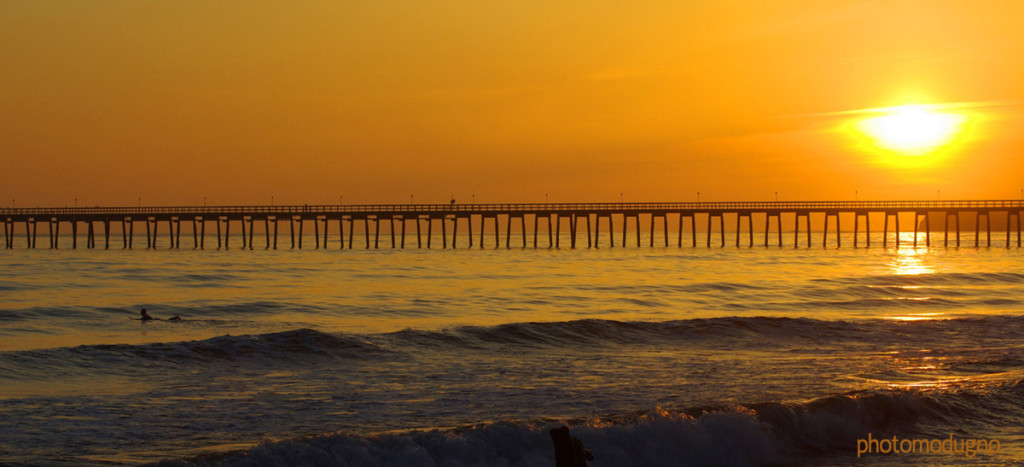 And in the foreground of many beautiful sunset shots.
And in the foreground of many beautiful sunset shots.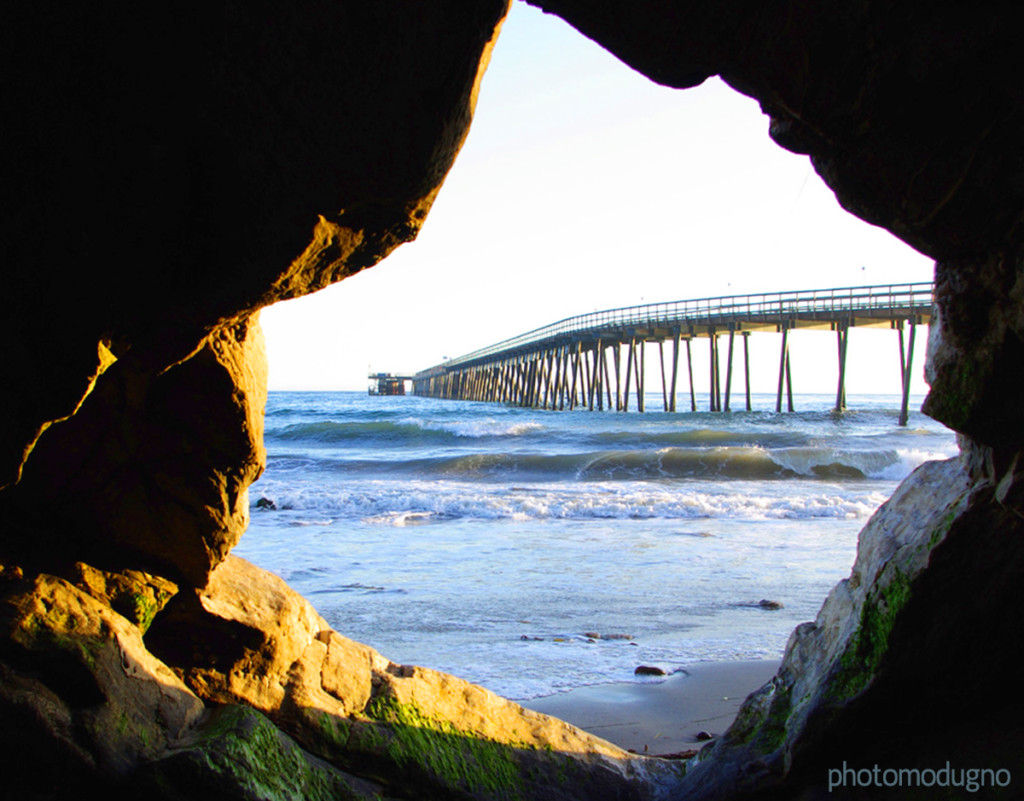
But it’s more than just a pretty prop, it has a lot of history and the story of its creation is pretty interesting.
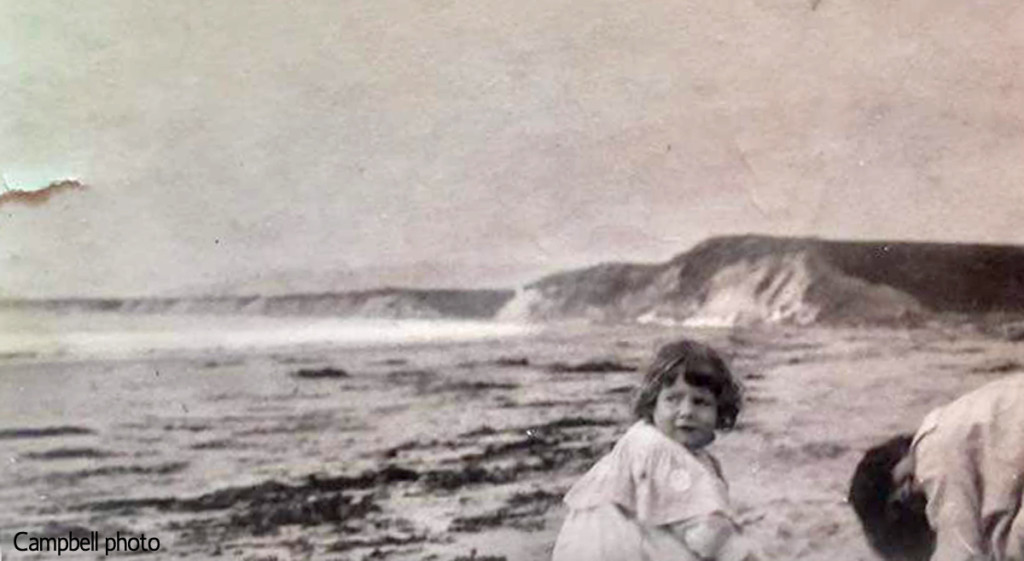
In the early days of Goleta, Haskells Beach was called Tecolote Canyon Beach. Before oil was discovered it was just a very remote beach, rarely visited, except by fisherman and ranchers.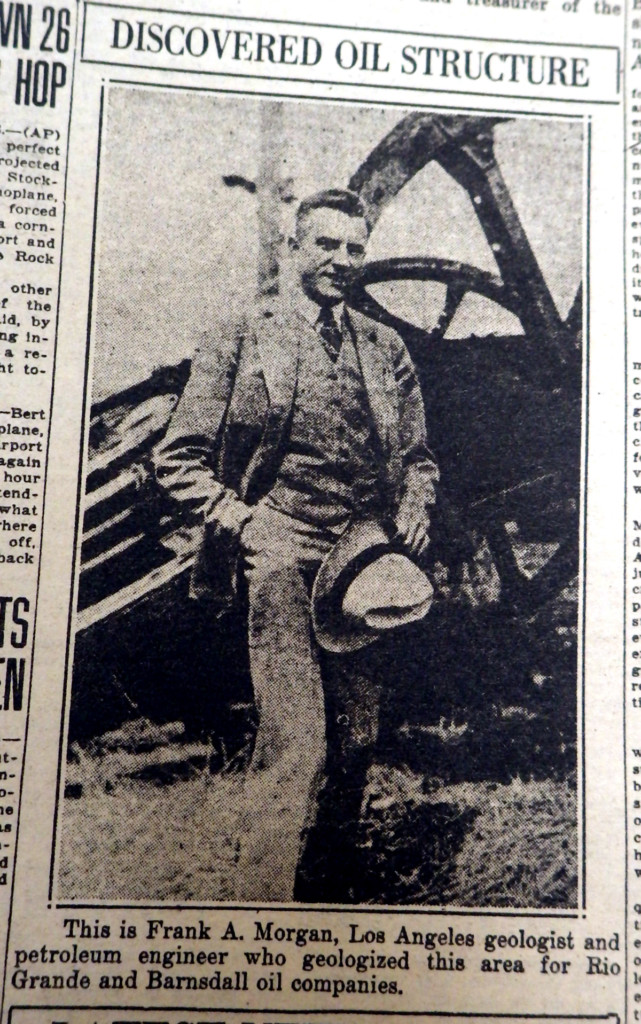 That all changed when Frank Morgan struck oil at Kate’s cactus near Ellwood in 1928.
That all changed when Frank Morgan struck oil at Kate’s cactus near Ellwood in 1928.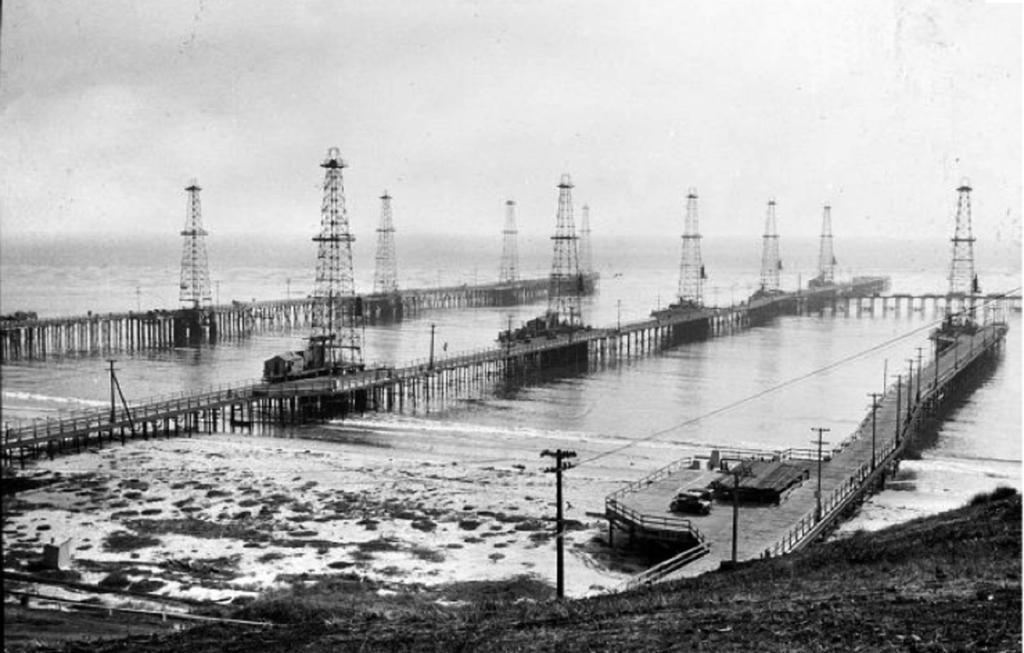
Almost overnight, oil piers popped up all along the Ellwood coast and the race was on to suck the black gold out of the ground. This guy, Sam Mosher, had been busy making his fortune in oil down in Long Beach. His upstart young company, Signal Oil and Gas, came to the Ellwood oil party a little late. But he had an uncanny ability to get things done against the odds and he knew he needed to get in on this action.
This guy, Sam Mosher, had been busy making his fortune in oil down in Long Beach. His upstart young company, Signal Oil and Gas, came to the Ellwood oil party a little late. But he had an uncanny ability to get things done against the odds and he knew he needed to get in on this action. 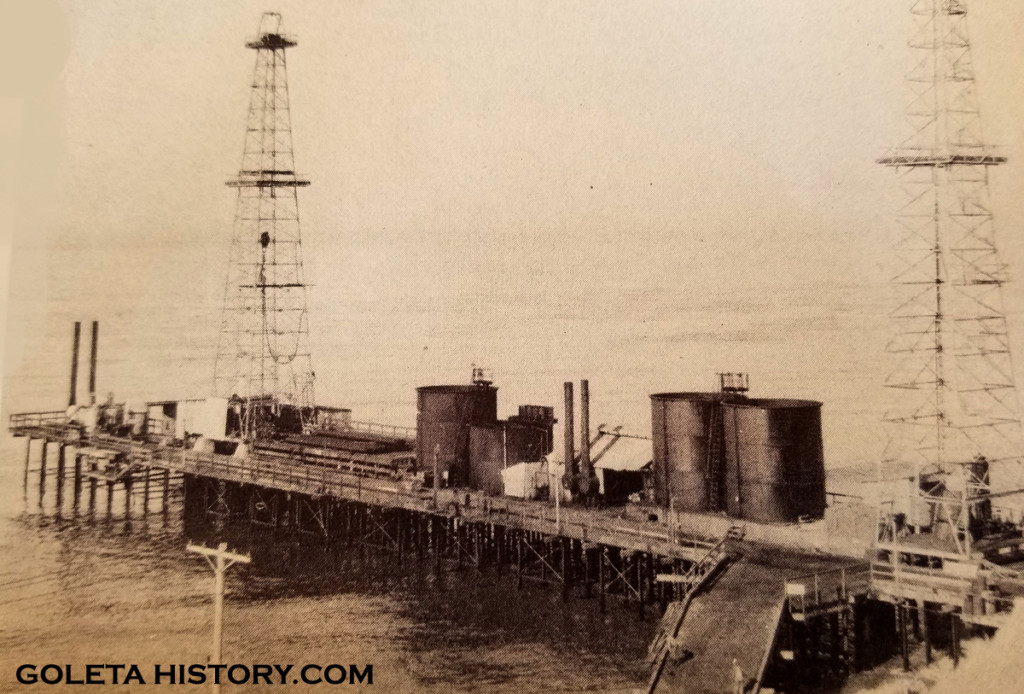 In 1929, Mosher managed to purchase an existing oil lease below what is today Sandpiper Golf Course. His team of experts had become pretty good at a new technique of drilling called “whipstocking”, which allowed them to drill off a pier in any direction, not just straight down. While they made the most of this small lease, his men scoured further up the coast looking for more opportunities.
In 1929, Mosher managed to purchase an existing oil lease below what is today Sandpiper Golf Course. His team of experts had become pretty good at a new technique of drilling called “whipstocking”, which allowed them to drill off a pier in any direction, not just straight down. While they made the most of this small lease, his men scoured further up the coast looking for more opportunities.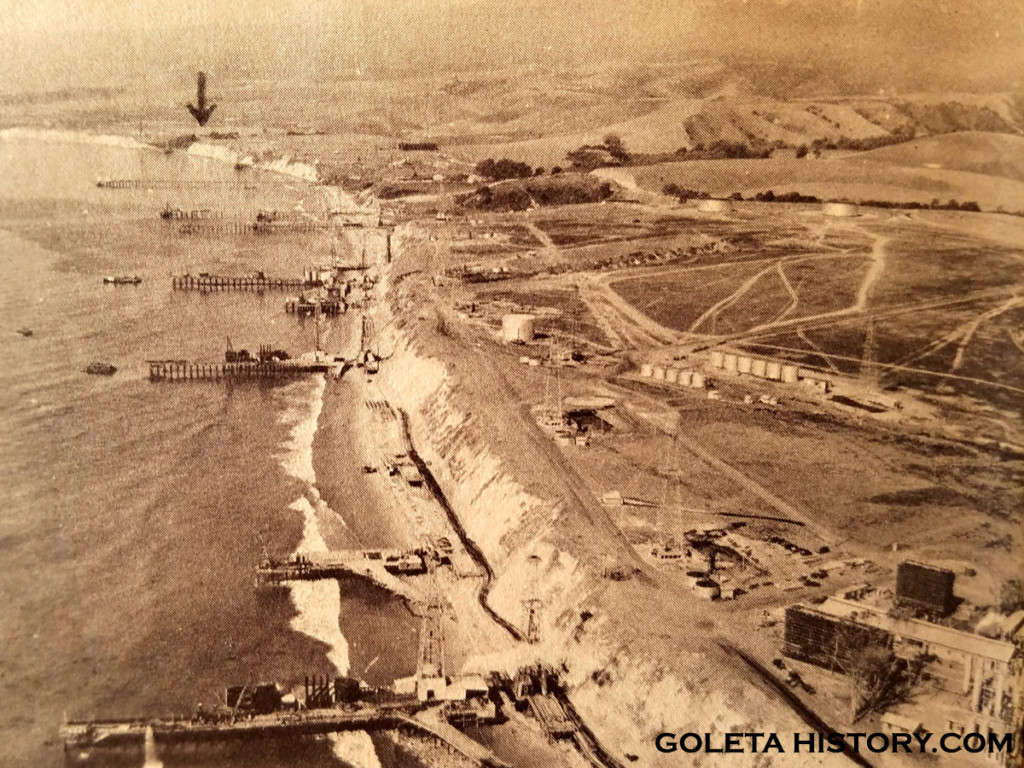 They found a promising situation a little further up the coast from the Ellwood oil fields. The arrow in this 1929 photo points to that opportunity, and the location of what is today the Haskells pier.
They found a promising situation a little further up the coast from the Ellwood oil fields. The arrow in this 1929 photo points to that opportunity, and the location of what is today the Haskells pier.
 About 400 yards east of the mouth of Eagle Canyon Creek, they found an oil lease that had been filed by a lawyer named William Appleford, but he never developed it. It was in front of a small gully nicknamed, “Hydrocarbon Gulch”. By law, a validation well had to be completed within 12 months of the application or the Appleford lease would be forfeited. Mosher had a good feeling about this place, but he found out there was very little time left to validate the lease before the 12 months would be up! He and his crew had 28 days to build a structure and drill a well just to keep the lease alive. Whether or not it struck oil was a whole other gamble…
About 400 yards east of the mouth of Eagle Canyon Creek, they found an oil lease that had been filed by a lawyer named William Appleford, but he never developed it. It was in front of a small gully nicknamed, “Hydrocarbon Gulch”. By law, a validation well had to be completed within 12 months of the application or the Appleford lease would be forfeited. Mosher had a good feeling about this place, but he found out there was very little time left to validate the lease before the 12 months would be up! He and his crew had 28 days to build a structure and drill a well just to keep the lease alive. Whether or not it struck oil was a whole other gamble…
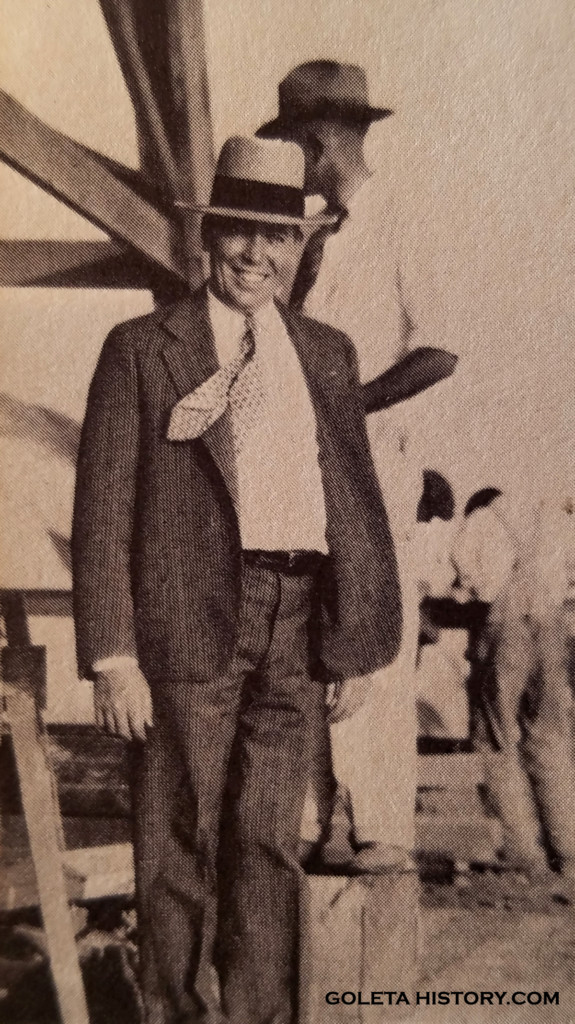 Sam Mosher and his young team were always optimistic and they very often took gambles to accomplish the impossible, and this challenge was one they couldn’t refuse. The first obstacle was to find a way to get the machinery and supplies to the mean high tide mark where the lease began. Hydrocarbon Gulch was a mere crack in the earth, choked with brush, that ended at a steep drop, straight down to heavy December surf pounding on the cliff. They needed to get to the foot of that cliff to build a short pier, but without crossing the railroad, because permission to do that would take far more time than they had.
Sam Mosher and his young team were always optimistic and they very often took gambles to accomplish the impossible, and this challenge was one they couldn’t refuse. The first obstacle was to find a way to get the machinery and supplies to the mean high tide mark where the lease began. Hydrocarbon Gulch was a mere crack in the earth, choked with brush, that ended at a steep drop, straight down to heavy December surf pounding on the cliff. They needed to get to the foot of that cliff to build a short pier, but without crossing the railroad, because permission to do that would take far more time than they had.
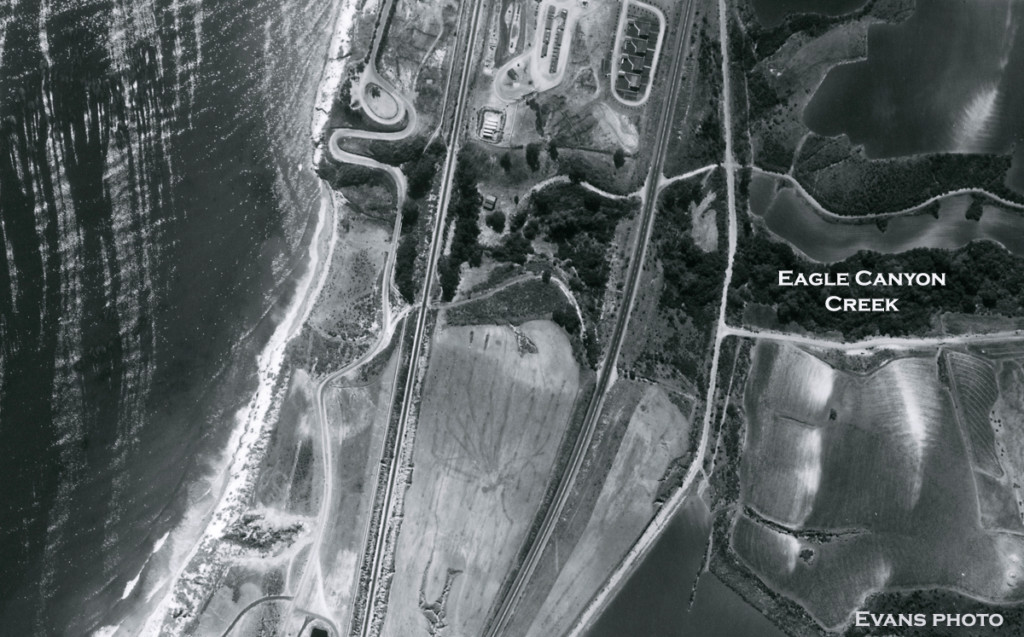 Mosher got permission to pass through the Eagle Canyon Ranch from the owner, Louis Dreyfus, while his Chief Engineer, Garth Young, discovered a passageway to the shore. An old stone culvert with 15 foot clearance passed underneath the railroad on the Eagle Canyon Creek. Built by the railroad in 1898, this culvert could be the answer to the first hurdle. Getting permission from the railroad to pass through this culvert would have also held them up, so Garth Young decided to do it without telling his boss, relieving Mosher of any responsibility.
Mosher got permission to pass through the Eagle Canyon Ranch from the owner, Louis Dreyfus, while his Chief Engineer, Garth Young, discovered a passageway to the shore. An old stone culvert with 15 foot clearance passed underneath the railroad on the Eagle Canyon Creek. Built by the railroad in 1898, this culvert could be the answer to the first hurdle. Getting permission from the railroad to pass through this culvert would have also held them up, so Garth Young decided to do it without telling his boss, relieving Mosher of any responsibility.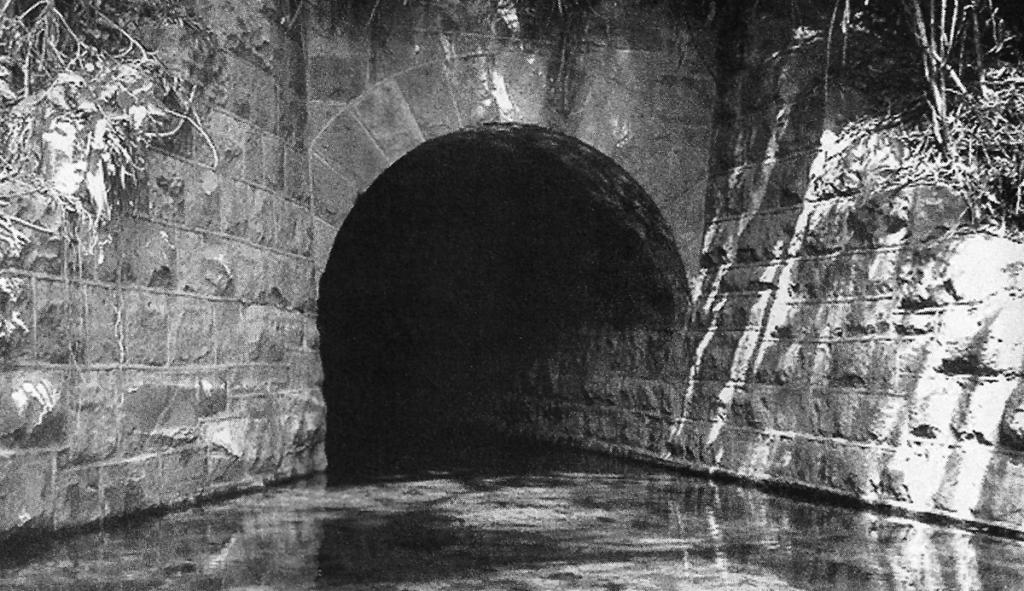 The heavy-duty self propelled power shovel made its way through the dry Eagle Canyon creek bed. As it approached the culvert, the operator lowered the boom to horizontal, the huge clamshell shovel blades mere inches off the ground. The prehistoric looking iron beast slowly crept through the dark stone tunnel, foot by foot, as Garth Young watched in suspense. Without a hitch, the giant piece of machinery crawled carefully through the dark tunnel and emerged into the daylight on the driftwood littered beach.
The heavy-duty self propelled power shovel made its way through the dry Eagle Canyon creek bed. As it approached the culvert, the operator lowered the boom to horizontal, the huge clamshell shovel blades mere inches off the ground. The prehistoric looking iron beast slowly crept through the dark stone tunnel, foot by foot, as Garth Young watched in suspense. Without a hitch, the giant piece of machinery crawled carefully through the dark tunnel and emerged into the daylight on the driftwood littered beach. 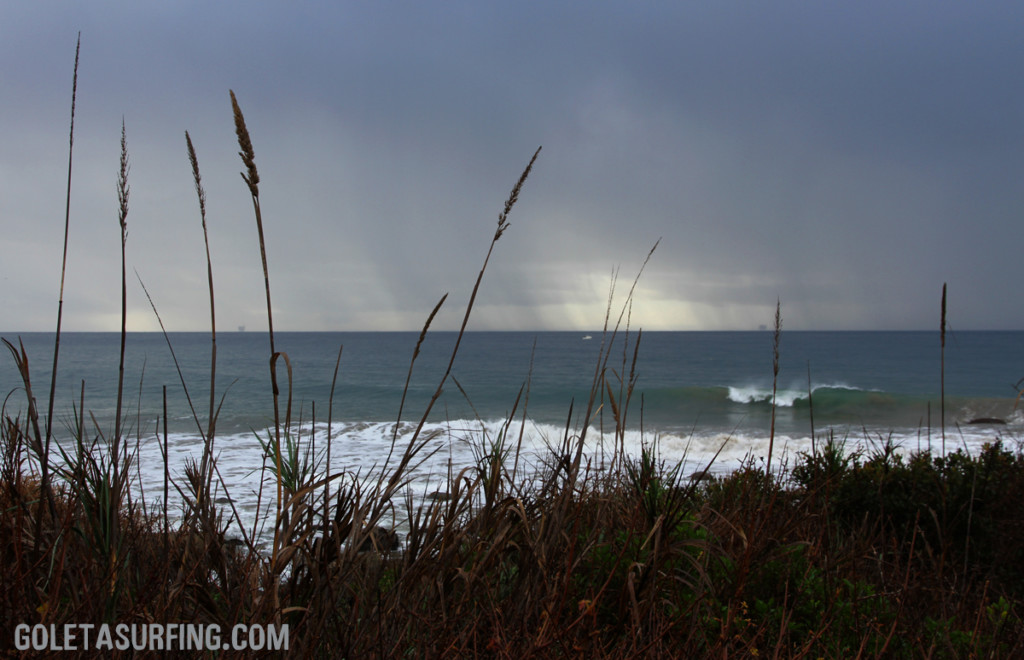 There the next hurdle greeted them; pounding winter surf and a rising tide.
There the next hurdle greeted them; pounding winter surf and a rising tide.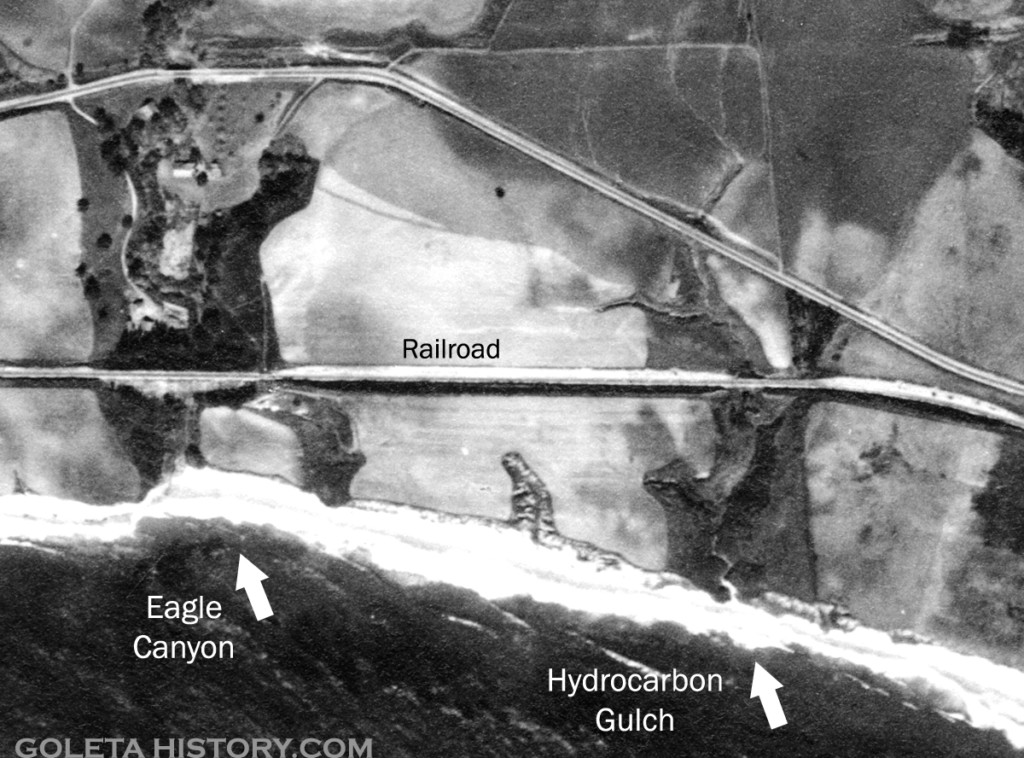 Garth explained to the shovel operator that he had to wait for the tide to drop, then hurry down the beach to the cliff, right below Hydrocarbon Gulch. Then quickly dig a foothold at the base of the cliff before the tide comes back up, or else be stuck in salty quicksand. The operator laughed at the crazy plan and said it would take him 10 days. He would drive back to the culvert every high tide and return on the next low. But Garth Young told him they didn’t have 10 days, it needed to be done, and done today. And if he didn’t succeed, they had insurance for the power shovel, which was a bit of a white lie….
Garth explained to the shovel operator that he had to wait for the tide to drop, then hurry down the beach to the cliff, right below Hydrocarbon Gulch. Then quickly dig a foothold at the base of the cliff before the tide comes back up, or else be stuck in salty quicksand. The operator laughed at the crazy plan and said it would take him 10 days. He would drive back to the culvert every high tide and return on the next low. But Garth Young told him they didn’t have 10 days, it needed to be done, and done today. And if he didn’t succeed, they had insurance for the power shovel, which was a bit of a white lie….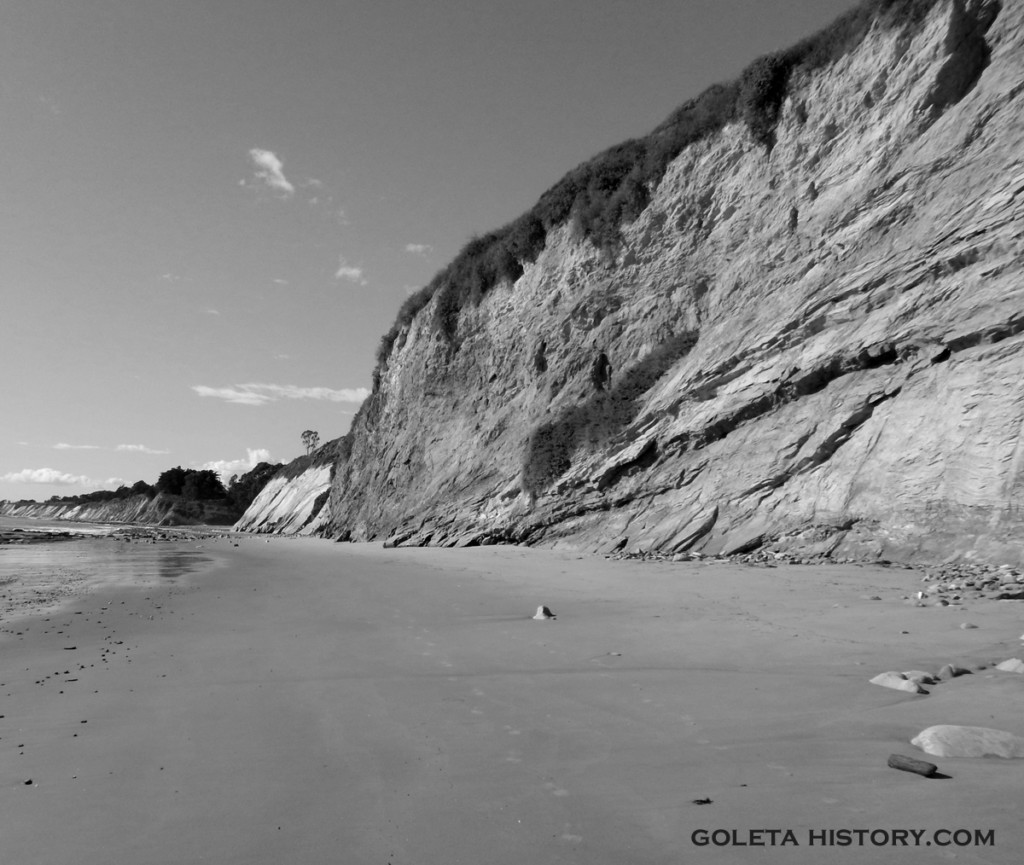 So, when the tide dropped just enough for the shovel to squeak by, the operator jammed through the driftwood and kelp piles to right down below Hydrocarbon Gulch, and then he tore into that cliff. Garth watched in amazement as the operator put on a display of masterful earthmoving, on a mission to prove his prowess to this bossy young city boy.
So, when the tide dropped just enough for the shovel to squeak by, the operator jammed through the driftwood and kelp piles to right down below Hydrocarbon Gulch, and then he tore into that cliff. Garth watched in amazement as the operator put on a display of masterful earthmoving, on a mission to prove his prowess to this bossy young city boy.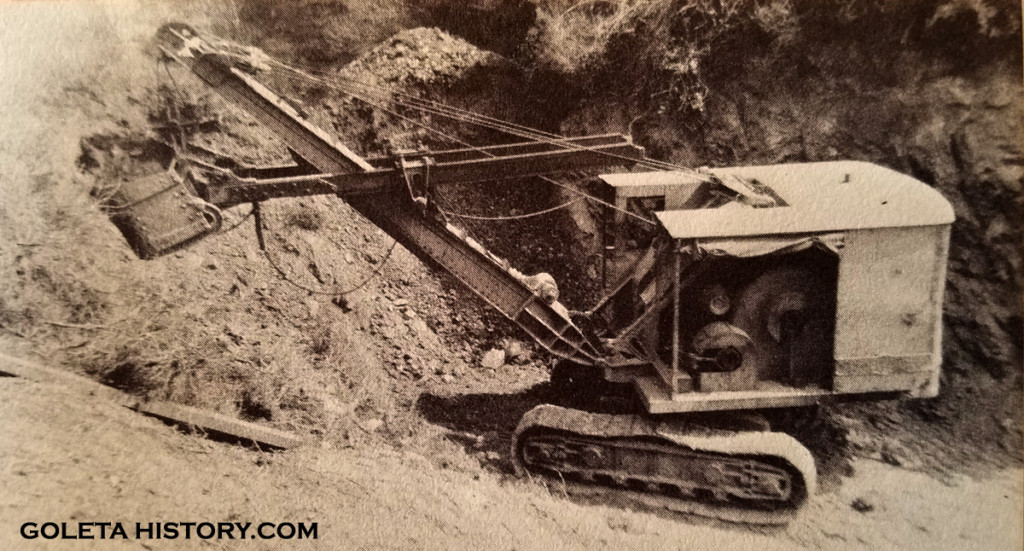 The blades ripped through the loose, crumbly shale and the operator whipped the shovel around to dump it on the beach, over and over again, a blur of precision on a massive scale. All the while the tide slowly worked its way through the cycle, like sand through an hourglass. The operator labored furiously, the sound of the pounding breakers taunting him. The minutes turned to hours as the 10 ton shovel dug deeper and deeper into the wall, until it had finally created a dry perch, just big enough to keep the giant machine safe from the highest tide. With the strong winter breakers literally nipping at his tracks, the operator kicked in the clutch and drove the mechanical beast up the short stone ramp to dry land. Without a lunch break or even a pause for a smoke, the shovel operator did the impossible with only minutes to spare.
The blades ripped through the loose, crumbly shale and the operator whipped the shovel around to dump it on the beach, over and over again, a blur of precision on a massive scale. All the while the tide slowly worked its way through the cycle, like sand through an hourglass. The operator labored furiously, the sound of the pounding breakers taunting him. The minutes turned to hours as the 10 ton shovel dug deeper and deeper into the wall, until it had finally created a dry perch, just big enough to keep the giant machine safe from the highest tide. With the strong winter breakers literally nipping at his tracks, the operator kicked in the clutch and drove the mechanical beast up the short stone ramp to dry land. Without a lunch break or even a pause for a smoke, the shovel operator did the impossible with only minutes to spare.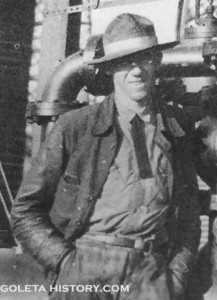 Garth Young gave him a standing ovation from atop Hydrocarbon Gulch, but he knew the work had only just begun….
Garth Young gave him a standing ovation from atop Hydrocarbon Gulch, but he knew the work had only just begun….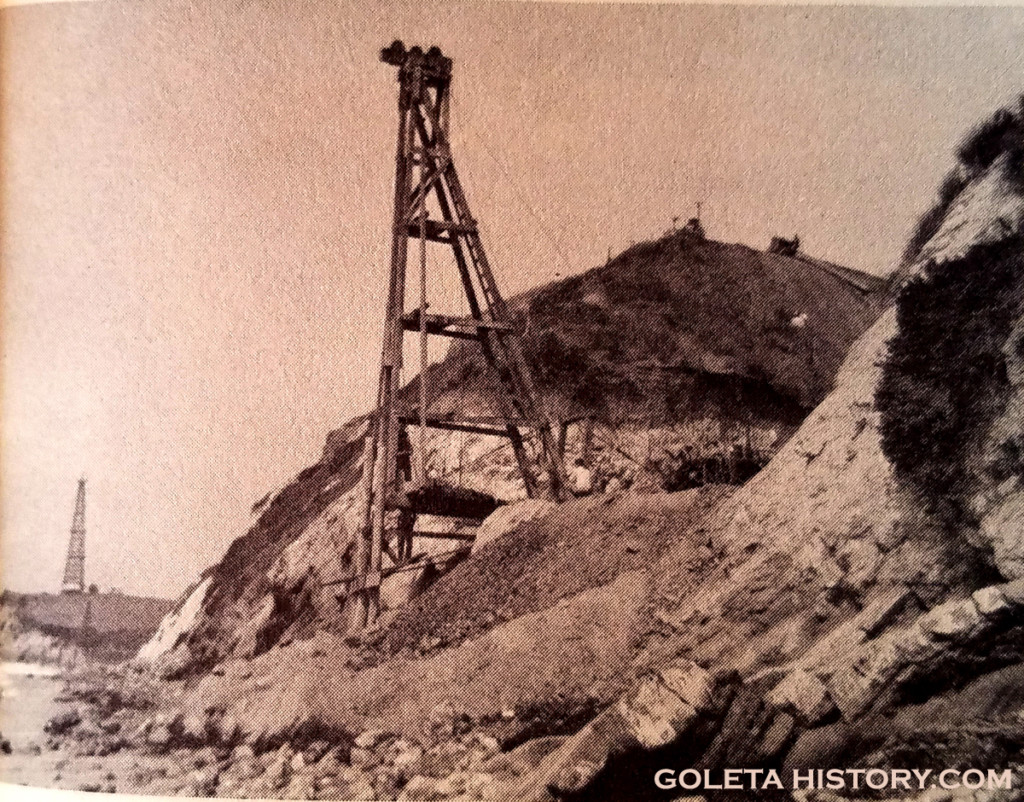 A few days later it was January 1st, 1930, the start of a new year. The Signal Oil construction crew was working 24/7 to beat the Appleford lease deadline of January 20th. A pile driver was brought to the beach in pieces and put back together on site. They hadn’t taken the time to widen Hydrocarbon Gulch yet, so wooden chutes were laid out at an angle to slide tons of supplies and materials off the cliff and down to the crews on the beach. On one unfortunate occasion, a foreman fell in a chute and took a deadly slip and slide down to the rocky beach below. Amazingly, he survived.
A few days later it was January 1st, 1930, the start of a new year. The Signal Oil construction crew was working 24/7 to beat the Appleford lease deadline of January 20th. A pile driver was brought to the beach in pieces and put back together on site. They hadn’t taken the time to widen Hydrocarbon Gulch yet, so wooden chutes were laid out at an angle to slide tons of supplies and materials off the cliff and down to the crews on the beach. On one unfortunate occasion, a foreman fell in a chute and took a deadly slip and slide down to the rocky beach below. Amazingly, he survived.  When the gulch was finally widened enough to make a proper access ramp, work began on the construction of a derrick and the tanks and boilers that were needed.
When the gulch was finally widened enough to make a proper access ramp, work began on the construction of a derrick and the tanks and boilers that were needed.
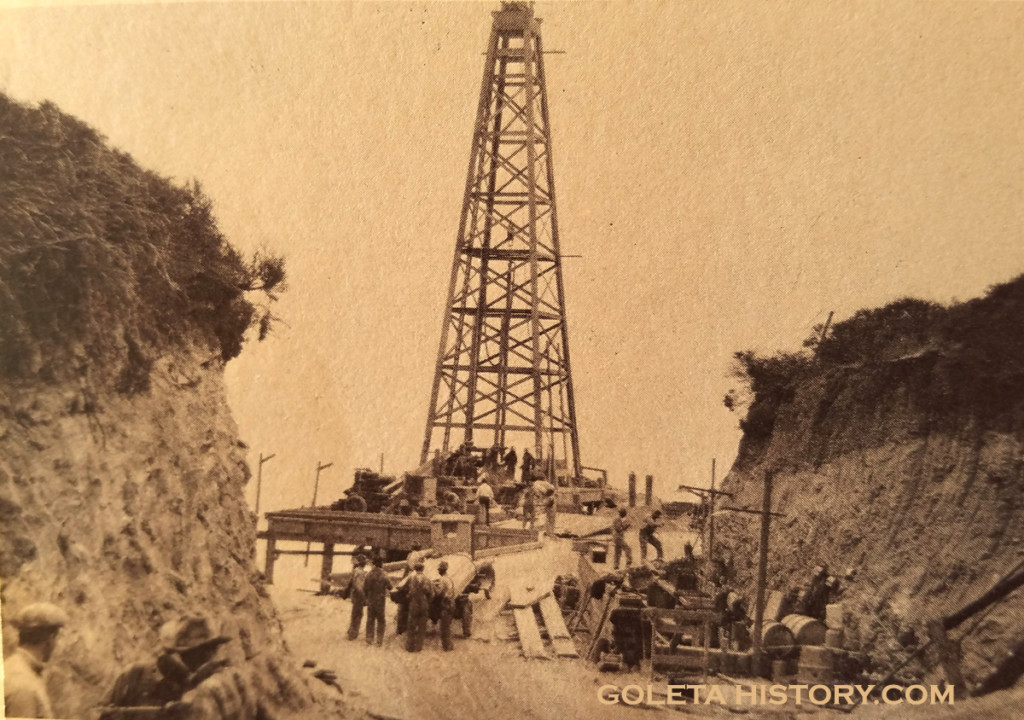 January 18th, just 48 hours before the 12 month limit on the Appleford lease would expire, the drilling platform was complete and they fired up the drill. The well at Hydrocarbon Gulch was officially “spudded in”, just before the legal deadline.
January 18th, just 48 hours before the 12 month limit on the Appleford lease would expire, the drilling platform was complete and they fired up the drill. The well at Hydrocarbon Gulch was officially “spudded in”, just before the legal deadline.
 They didn’t get a drop of oil, but they didn’t really expect to. This was merely a validation well to keep the lease active. Now, the next step was to build a pier to get out far enough to reach where the geologists believed the oil would be found. Garth Young was already back in his office, drawing up the plans for a 1,500 foot pier. If the well at the end of this pier came up dry, all this labor, stress and use of resources would have been for nothing.
They didn’t get a drop of oil, but they didn’t really expect to. This was merely a validation well to keep the lease active. Now, the next step was to build a pier to get out far enough to reach where the geologists believed the oil would be found. Garth Young was already back in his office, drawing up the plans for a 1,500 foot pier. If the well at the end of this pier came up dry, all this labor, stress and use of resources would have been for nothing.
 By February of 1930, timber and steel was hauled in for the beginning of what would be a long and difficult task. An unusually stormy spring wreaked havoc on the construction process, with progress repeatedly wiped out or delayed. Powerful surf and currents ripped pilings out of the ground and even threatened construction on shore. By April, they had finished the foundation for a well 500 feet offshore, in 30 feet of water. This was an especially big deal for Signal Oil because it was their first offshore well ever.
By February of 1930, timber and steel was hauled in for the beginning of what would be a long and difficult task. An unusually stormy spring wreaked havoc on the construction process, with progress repeatedly wiped out or delayed. Powerful surf and currents ripped pilings out of the ground and even threatened construction on shore. By April, they had finished the foundation for a well 500 feet offshore, in 30 feet of water. This was an especially big deal for Signal Oil because it was their first offshore well ever.
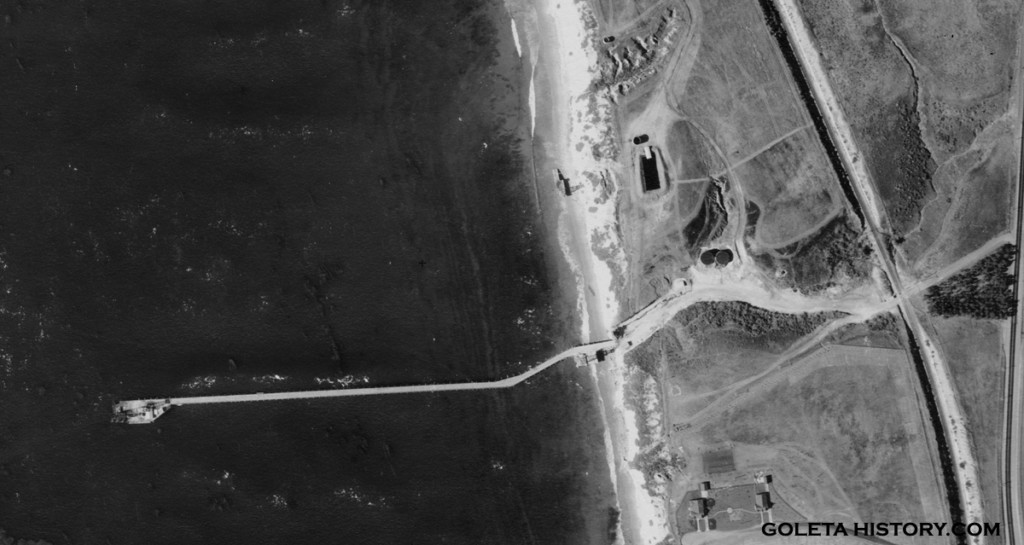
The well on their brand new pier struck oil in July 1930, but it wasn’t what you’d call a gusher. It produced a meager flow, but Sam Mosher wasn’t discouraged by this. It would pay for itself, and it justified an extension. He still had a good feeling about this spot. But the United States was heading into the Great Depression, and some serious internal restructuring had to be done to keep Signal Oil in business. 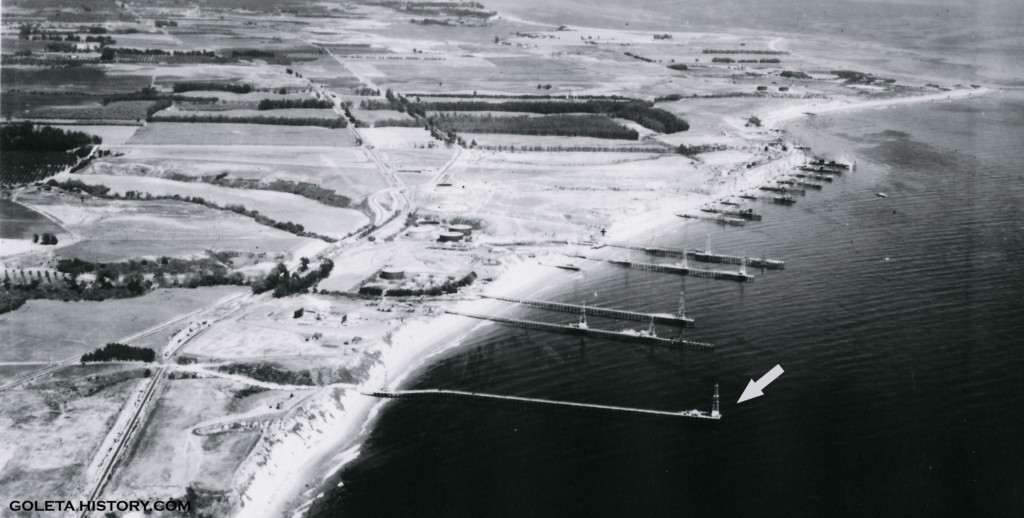 Signal Oil was carefully making its way through the lean years of the Depression when, in 1934, they decided to take another expensive gamble. They were teetering on the edge of bankruptcy, and they needed a boost. Mosher’s team believed they could “whipstock” a well off the end of their pier on the Appleford lease and hit a substantial oil field.
Signal Oil was carefully making its way through the lean years of the Depression when, in 1934, they decided to take another expensive gamble. They were teetering on the edge of bankruptcy, and they needed a boost. Mosher’s team believed they could “whipstock” a well off the end of their pier on the Appleford lease and hit a substantial oil field.
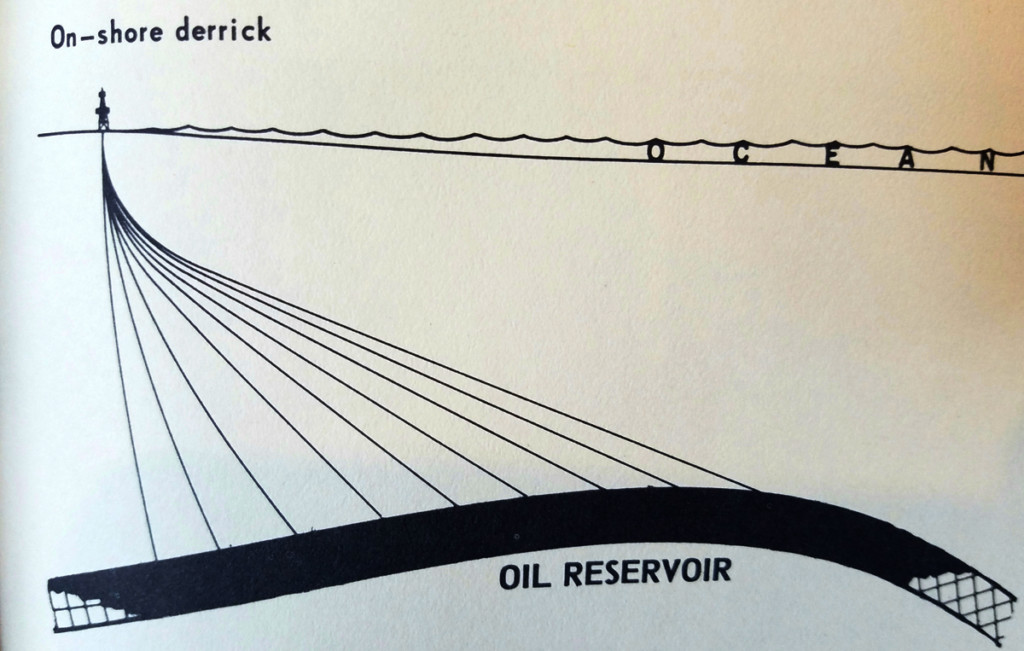 Whipstocking is a form of slant drilling that allows a much wider field of exploration from an existing well. Signal Oil had everything riding on this gamble; it was literally a do or die proposition.
Whipstocking is a form of slant drilling that allows a much wider field of exploration from an existing well. Signal Oil had everything riding on this gamble; it was literally a do or die proposition.
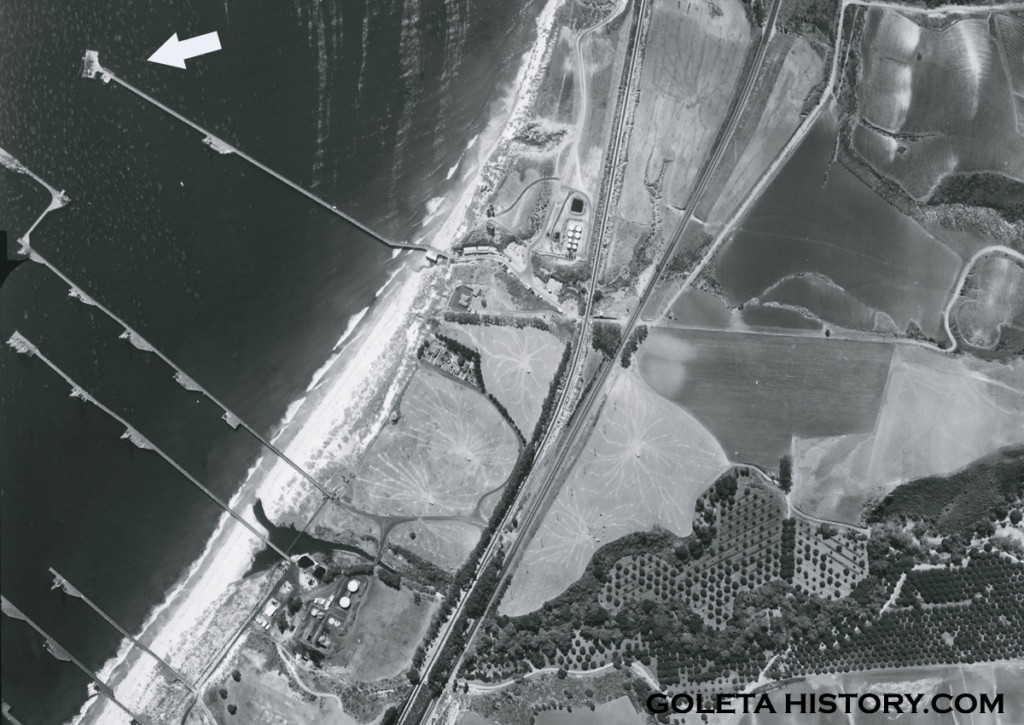 Early November 1934, a small trickle of oil came in from the new well off the end of the pier. It seemed like the gamble was lost and Signal began to prepare for the worst. But a few days later, they drilled a little deeper and a powerful flow came bursting through.
Early November 1934, a small trickle of oil came in from the new well off the end of the pier. It seemed like the gamble was lost and Signal began to prepare for the worst. But a few days later, they drilled a little deeper and a powerful flow came bursting through.  The little pier at Hydrocarbon Gulch saved the company from bankruptcy. Sam Mosher instructed his crew to have a celebration party and he would pick up the tab. This would go down as the most important strike in the history of Signal Oil. It not only got them through the Great Depression, it propelled the company to a whole new level of success.
The little pier at Hydrocarbon Gulch saved the company from bankruptcy. Sam Mosher instructed his crew to have a celebration party and he would pick up the tab. This would go down as the most important strike in the history of Signal Oil. It not only got them through the Great Depression, it propelled the company to a whole new level of success. Signal Oil invested heavily in the Appleford lease, building a processing plant in Hydrocarbon Gulch, and extending the pier another 800 feet out to sea. This created drill sites closer to the productive area and 6 new wells brought in more profits. The further they went, the more oil and gas they found and the wells on the Appleford lease were big money makers for years to come.
Signal Oil invested heavily in the Appleford lease, building a processing plant in Hydrocarbon Gulch, and extending the pier another 800 feet out to sea. This created drill sites closer to the productive area and 6 new wells brought in more profits. The further they went, the more oil and gas they found and the wells on the Appleford lease were big money makers for years to come.

The outbreak of WW II brought danger to the Ellwood oil fields. On February 23rd, 1942, a Japanese submarine bombarded the oil field. Fortunately, very little physical damage was actually done, and the pier at Hydrocarbon Gulch was untouched.

In the 1950’s the piers at Ellwood were just part of the scenery and didn’t keep Goleta locals from enjoying the beach. It was still a great place to get a tan and to catch some fish.
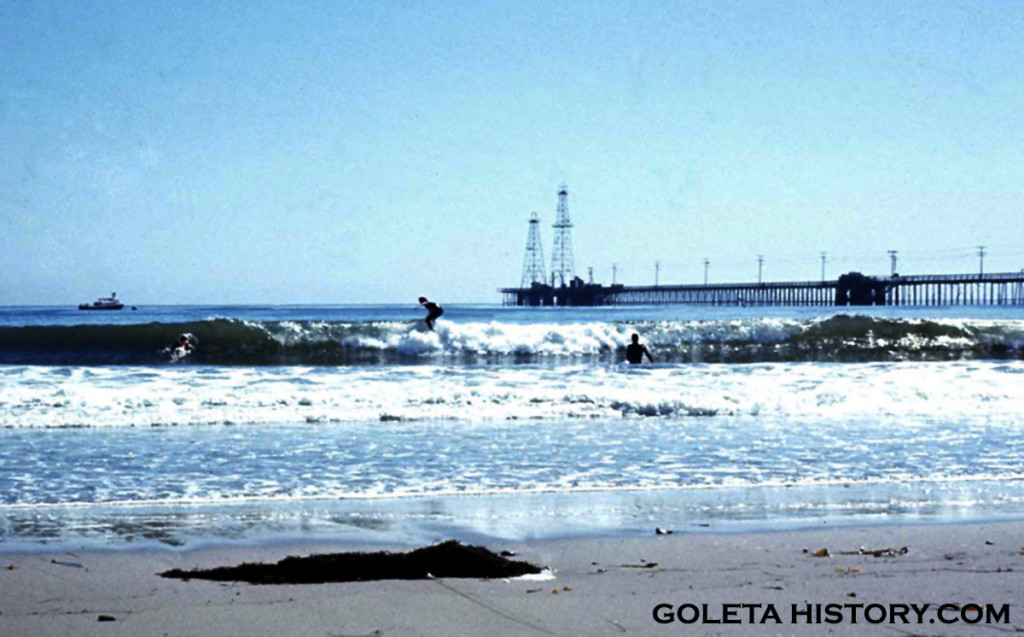 Generations of Goleta folks have grown up on Haskells beach with the Appleford pier silent in the background.
Generations of Goleta folks have grown up on Haskells beach with the Appleford pier silent in the background.

This photo of a local beauty from 1968 shows the dilapidated condition of the pier at that point.
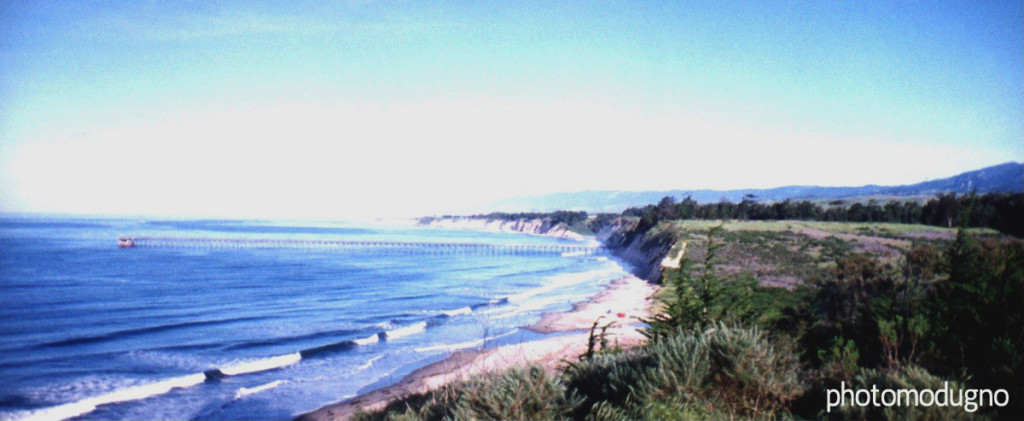
The beach the locals named Haskells has undergone a lot of changes through the years, but the pier has remained a constant.
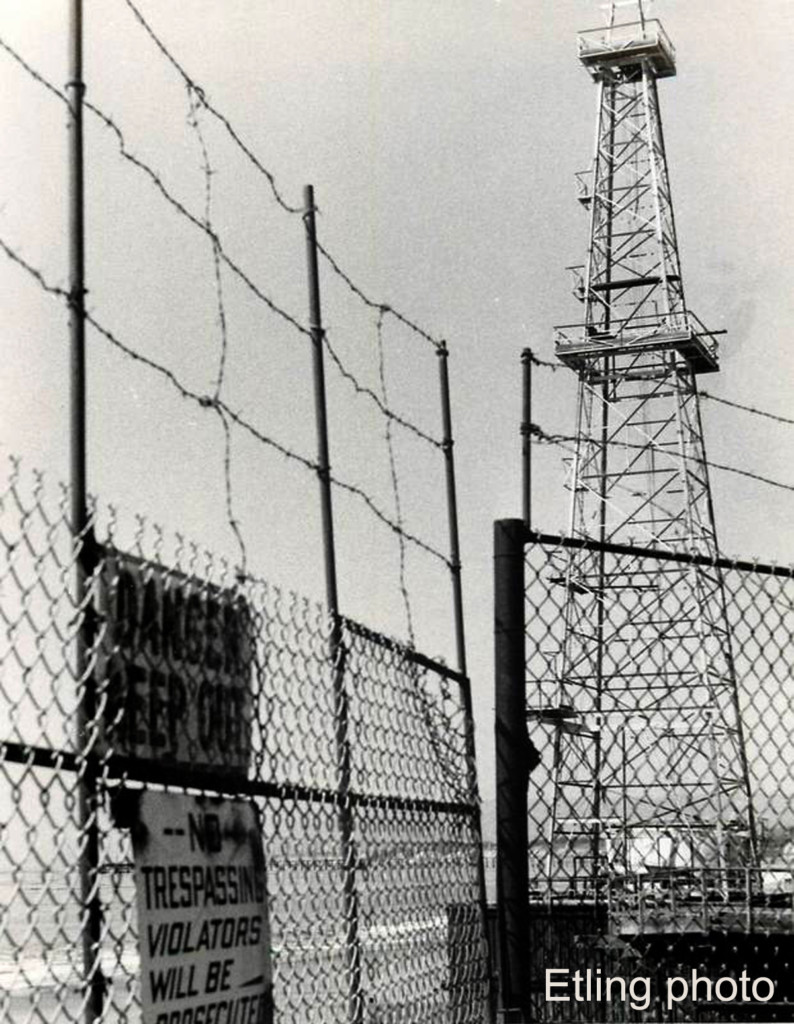 In the late 1970’s, the old oil piers along the Ellwood coast were in pretty bad shape.
In the late 1970’s, the old oil piers along the Ellwood coast were in pretty bad shape. 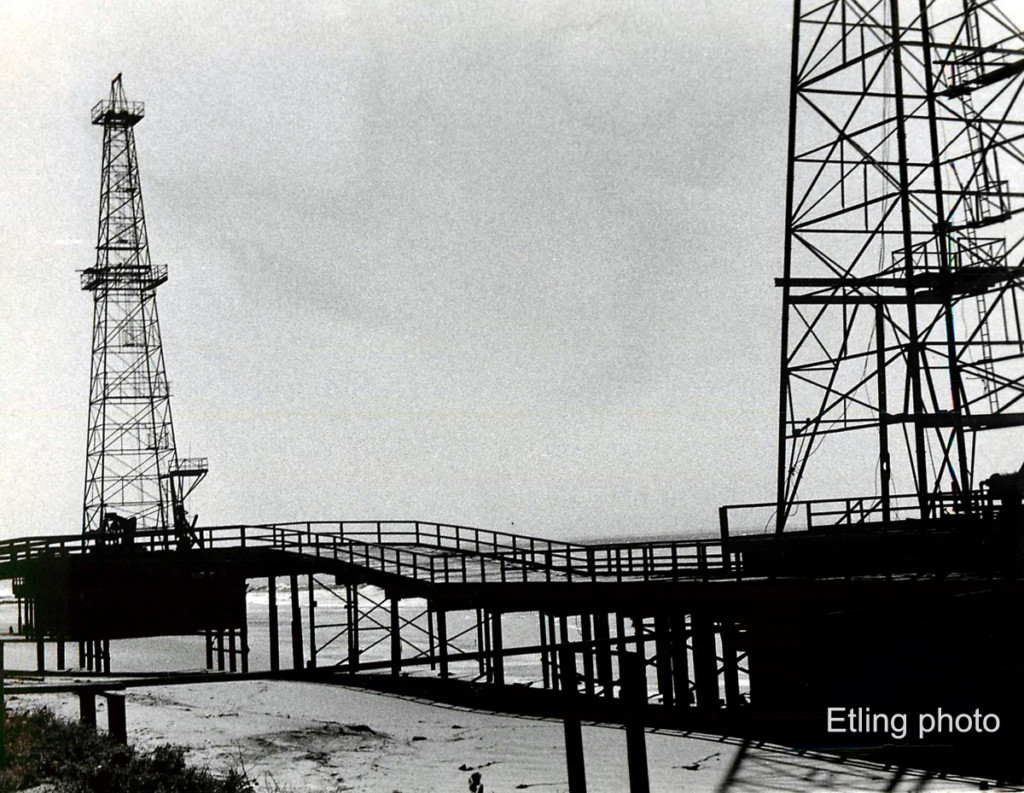 Most had been abandoned and forgotten, and walking on or around them had become quite dangerous.
Most had been abandoned and forgotten, and walking on or around them had become quite dangerous.  Not long after these photos were taken, most of the Ellwood oil piers were removed with the use of explosives.
Not long after these photos were taken, most of the Ellwood oil piers were removed with the use of explosives. The Appleford pier was spared, however, because it was still being used by the oil companies. Note the old pilings in the tide line that weren’t cleared out for years to come.
The Appleford pier was spared, however, because it was still being used by the oil companies. Note the old pilings in the tide line that weren’t cleared out for years to come.
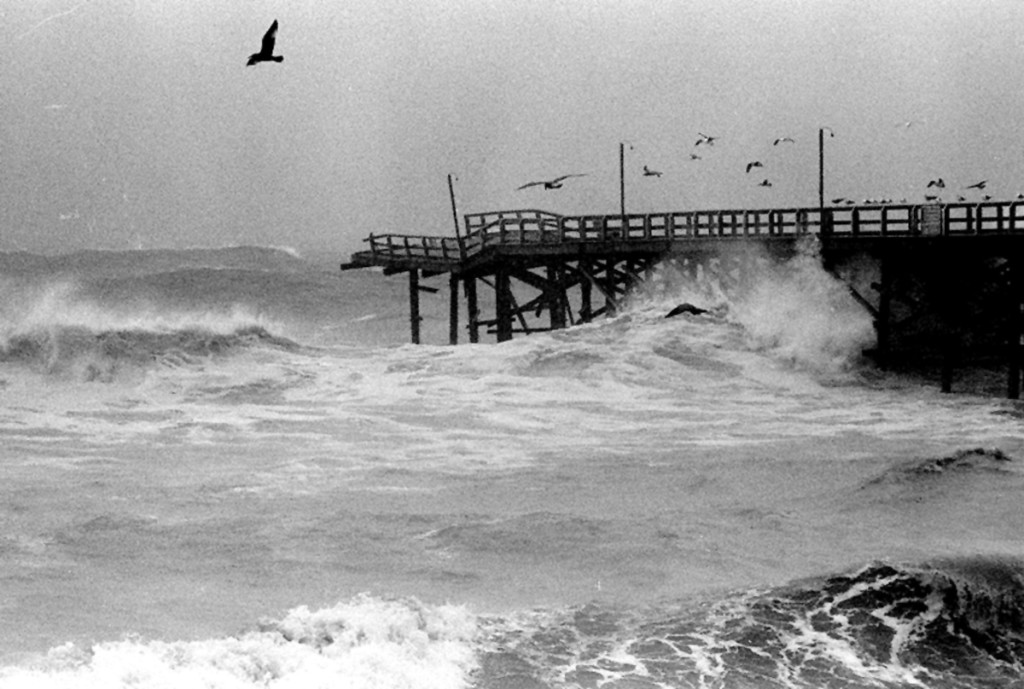 In 1983, a powerful winter storm broke the end of the pier off. An avid surfer at the time, Tim Kelly recalls watching gigantic waves breaking beyond the end of the pier. When a massive set came through, the last third of the Appleford pier broke off and was washed away.
In 1983, a powerful winter storm broke the end of the pier off. An avid surfer at the time, Tim Kelly recalls watching gigantic waves breaking beyond the end of the pier. When a massive set came through, the last third of the Appleford pier broke off and was washed away. 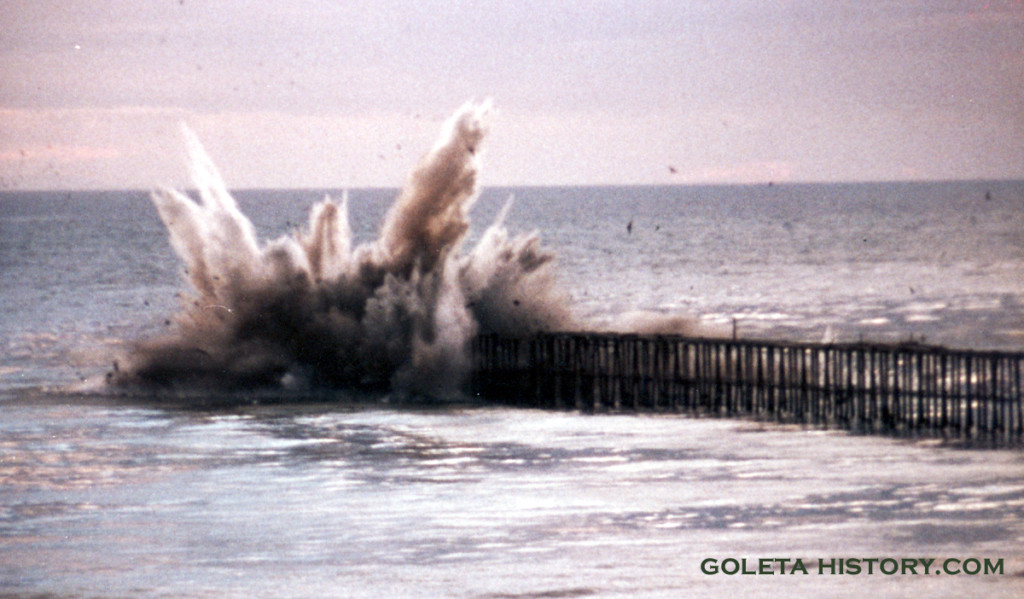 At one point they used explosives to shorten the length of the pier, shown here. A while later, the old wooden pilings were replaced with strong steel pilings.
At one point they used explosives to shorten the length of the pier, shown here. A while later, the old wooden pilings were replaced with strong steel pilings. In the late 1990’s, developers built a hotel at Haskells beach, but because the Appleford pier was on the next parcel up, it was not affected.
In the late 1990’s, developers built a hotel at Haskells beach, but because the Appleford pier was on the next parcel up, it was not affected.
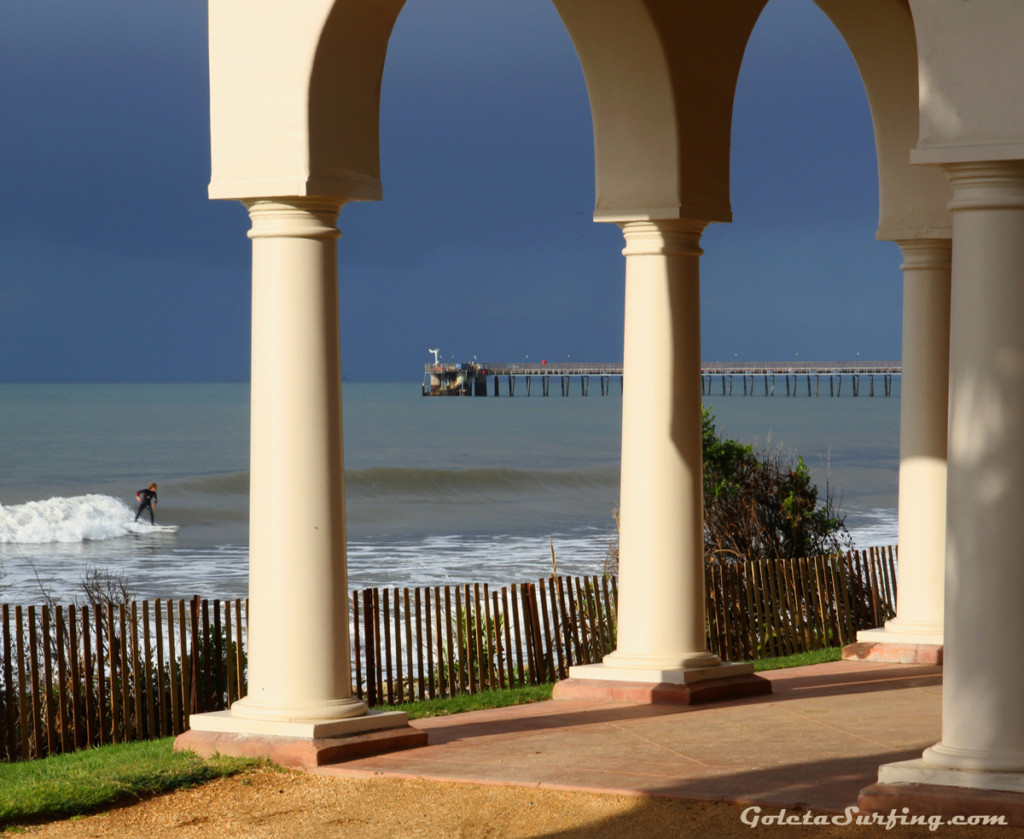
And the pier continued to be the back drop for day to day life at the beach in Goleta.
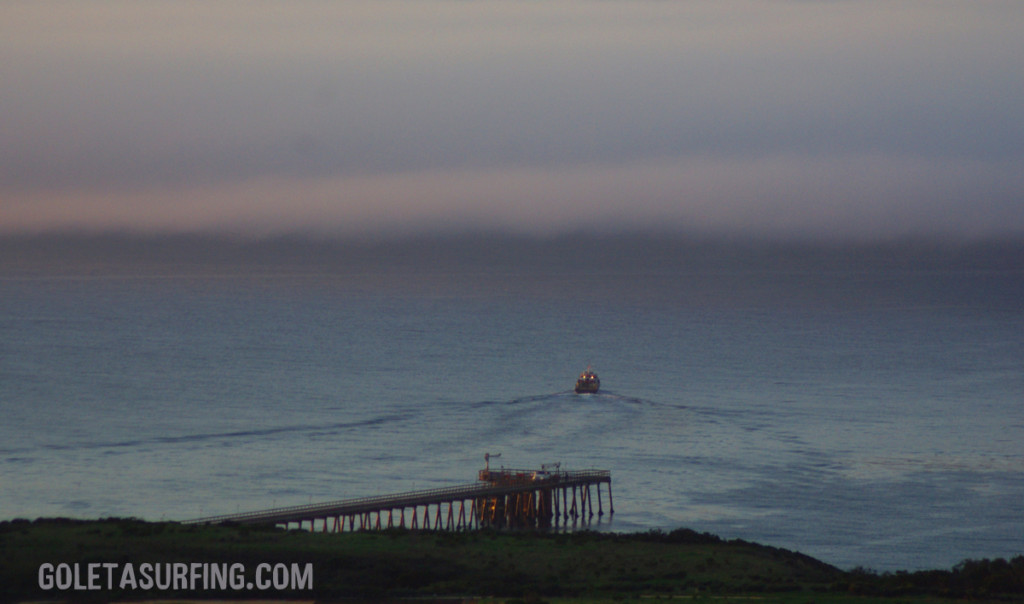 The future of the pier is now in limbo.
The future of the pier is now in limbo.  The company that uses it, Venoco Oil and Gas, is in bankruptcy, and will no longer be leasing the pier.
The company that uses it, Venoco Oil and Gas, is in bankruptcy, and will no longer be leasing the pier.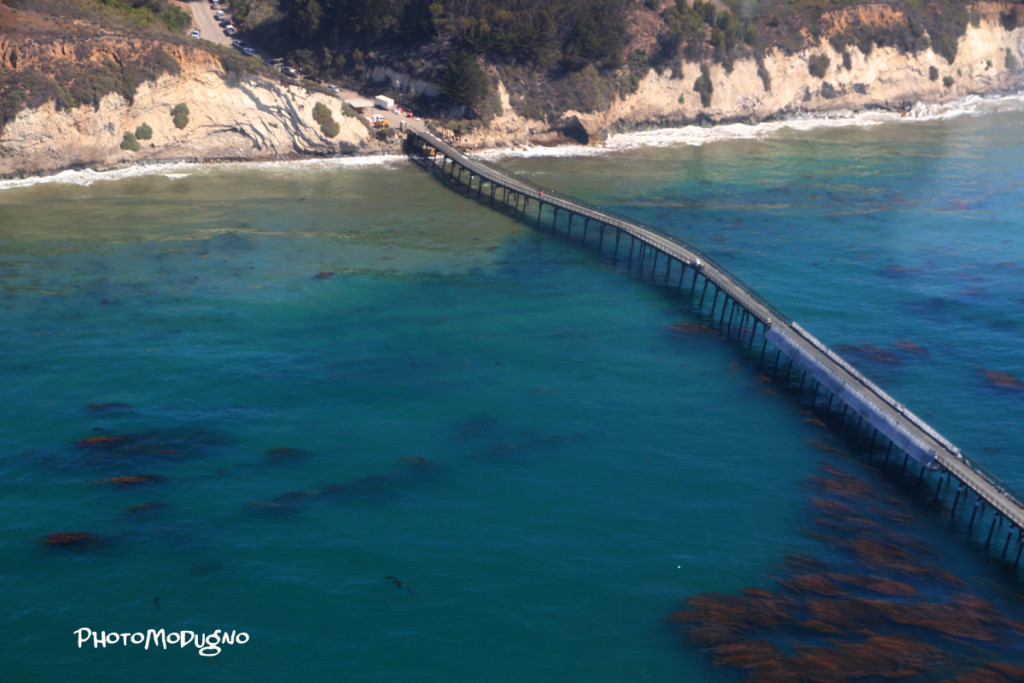 It will most likely be taken over by the State, who might dismantle it, or make it public…
It will most likely be taken over by the State, who might dismantle it, or make it public…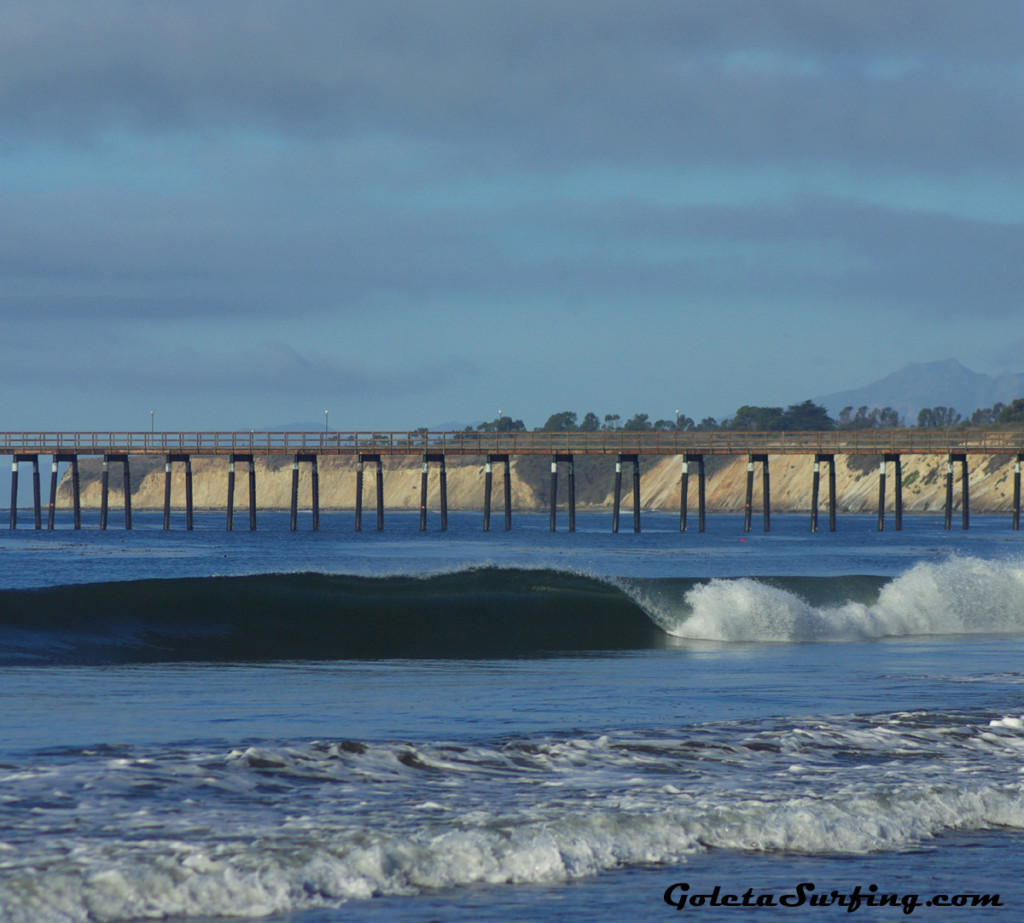 While it was built strictly for monetary gain and corporate profit, this pier has become an icon in our community, a part of our memories and our life.
While it was built strictly for monetary gain and corporate profit, this pier has become an icon in our community, a part of our memories and our life.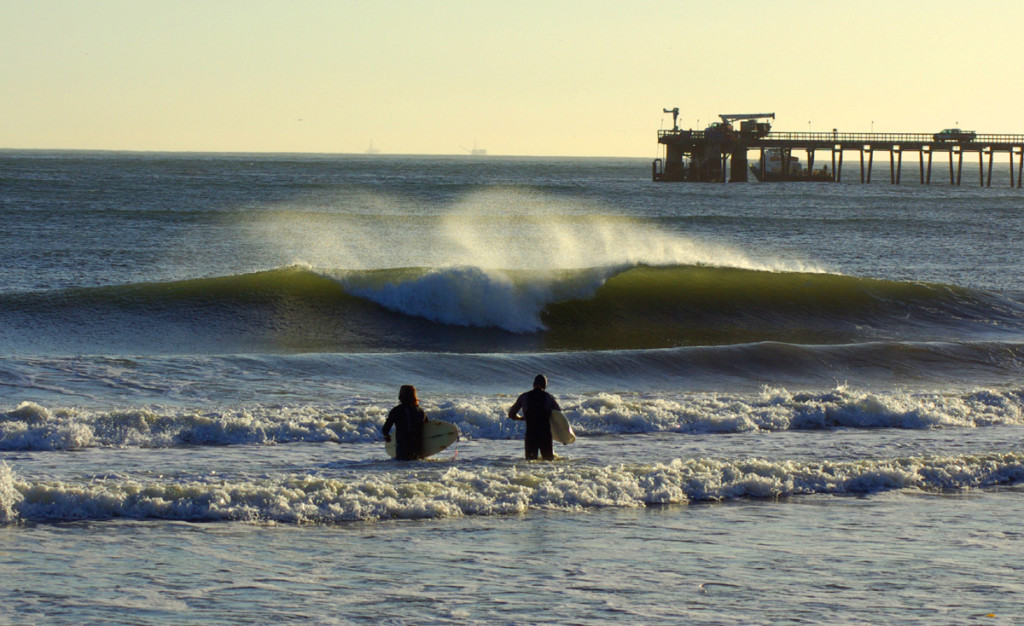 We hope the powers that be find a way to use the pier that will benefit the people of Goleta.
We hope the powers that be find a way to use the pier that will benefit the people of Goleta.
Like all things in history, only time will tell.
Sources: Gail Campbell, Walker Tompkins, UCSB, Rob Evans, Jeff Campbell, Elliot Harris, Donna Doty-Lane, Tim Kelly, William Etling, Peter Moffat and special thanks to Ron Harkey.
Categories: Goleta History
Very informative article Tom…great work as always!
Awesome Tom!
We share a lot of your information on our private rail car day trips. Great research and report, Tom!
Thanks Terry! Glad to be of service.
You are quite the historian!
Thank you Professor Modugno
Really enjoyable as usual. I have some side information related to Sam Mosher that I’ll write separately, you may already have but will mention
anyhow.
Thanks for keeping Goleta’s rich history alive! Keep up the great work.
As usual you have told a great story of our history in the Goodland, we love to hear them. Keep up the great work… Locs!
Thanks, my pleasure!
My grandfather, Bruce Cameron Hall was a whipstocking expert and was responsible for the whipstocking which was begun at the gulch in 1934. He was one of the drillers who began experimenting with this technique down in Summerland. He always said it was a good way to pump oil from another companies lease. He had worked for Barnsdahl until they went bankrupt and then Sam Moser. He stayed with Moser and Signal until his death in 1959.
Fascinating! Thanks for sharing that. Moser seemed to have a way of keeping his employees loyal.
Great stories and pictures Tom. Sure make me miss Goleta and Haskulls. I visit there everytime i got to Goleta and SB. Thanks Tom
thanks Jon.
Great article. The oil piers Were great for exploring and fishing. We used to jump off the pier and paddle up to Driftwood and deadman’s when the surf got too big to paddle out. Had some awesome surf session. That stretch of beach all the way up to Naples and nowhere’s was home back in the day. Loved growing up there. Thanks again for sharing this article. Sure brought back. Lots of memories.
A special stretch of beach for sure…
I did not know.